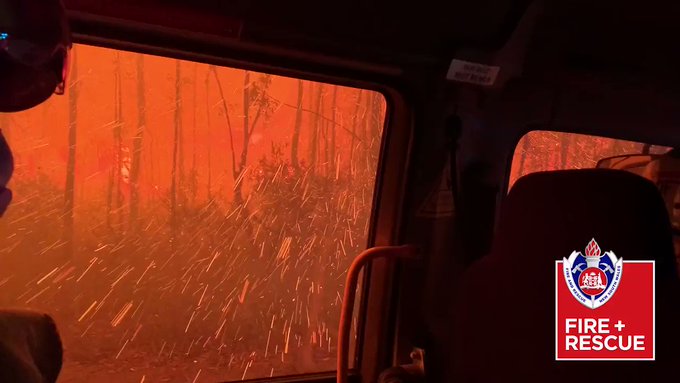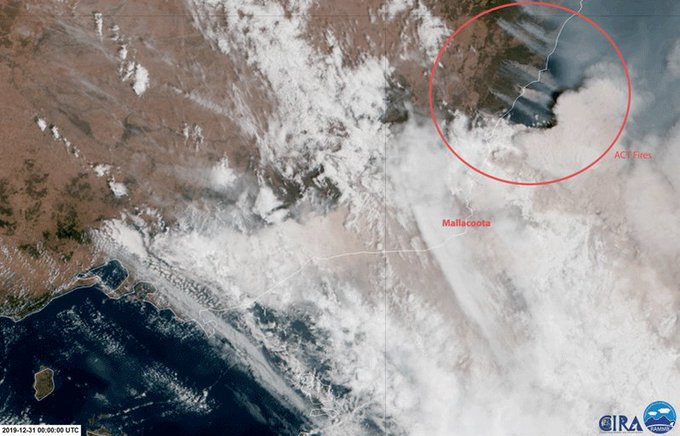Updated Dec. 31, 2019 4:51 PM
Thousands of residents and vacationers in Australia were forced to quickly take refuge on a beach in Mallacoota, Victoria, Tuesday as a large fire threatened the seaside town located about 500 km (310 miles) east of Melbourne.
Fire crews flanked the beach as the flames grew closer, and some people were able to flee the beach using local boats. Others hunkered down on their boats away from land, with little choice but to wait out the disastrous flames until additional help arrived.
The daytime sky glowed dark red and orange and then black as massive plumes of smoke and ash enshrouded the region.

In this Monday, Dec. 30, 2019 photo provided by State Government of Victoria, a helicopter tackles a wildfire in East Gippsland, Victoria state, Australia. Wildfires burning across Australia's two most-populous states trapped residents of a seaside town in apocalyptic conditions Tuesday, Dec. 31, and were feared to have destroyed many properties and caused fatalities. (State Government of Victoria via AP)
The Australian Defense Force was mobilized to rescue those still stranded on the beach, according to the Herald News.
The Australian Navy and a group of military helicopters were being sent to the area to supply aid and provide evacuations.
Homes were reportedly destroyed and residents forced to flee as a fire approached the New South Wales town of Batemans Bay on Tuesday.
Batemans Bay resident Zoe Simmons described the scene as “apocalyptic” when smoke and flames turned the sky red.
Simmons said on Twitter she was at an evacuation center in town and at one point couldn't stand outside because ash was getting in her eyes.
For months, devastating bushfires have ravaged Australia, and conditions show no sign of improving as 2020 begins.
More than 200 fires continued to burn out of the control across New South Wales and Victoria, according to Reuters.

Despite some improvement to the weather this week, fire crews still have a major challenge to overcome.
Intense heat and gusty winds caused the fires to spread quickly across Victoria and New South Wales on Tuesday. In locations farther south, cooler air and less wind provided some aid to firefighters that struggled to get control over the recent surge in fires.

In this image made from video, officials block the Princes Highway as wildfires approach in South Coast, New South Wales Australia, Tuesday, Dec. 31, 2019. (Australian Broadcasting Corporation, Channel 9, Channel 7 via AP)
Two men were killed while trying to protect their home in New South Wales, and another remained missing, according to the Associated Press.
A firefighter who was killed in New South Wales on Monday marked the third death in firefighting efforts since mid-December.

This Monday, Dec. 30, 2019 photo provided by State Government of Victoria shows wildfires in East Gippsland, Victoria state, Australia. (State Government of Victoria via AP)
Four other people were reported missing in fire devastated locations across Victoria.
There is such a large amount of smoke it is producing pyrocumulus clouds which can be seen from NOAA Satellites.
Since the start of the ongoing bushfire catastrophe, 12 lives have been lost, more than 1,000 homes destroyed and more than 5 million hectares (12.35 million acres) have been burned.
Relief from the heat will aid firefighting efforts across Victoria and eastern New South Wales on Thursday before conditions begin to worsen on Friday.

Strengthening winds and elevated temperatures will elevate the risk of new fires and make containing ongoing blazes more difficult from Friday into Saturday.
Another surge of cooler air will sweep across Victoria and southern and eastern New South Wales on Sunday, which will bring some relief.
Sunday may also mark the first widespread rainfall to the region in weeks. However, any lightning from thunderstorms will pose a risk to ignite additional fires.





No comments:
Post a Comment